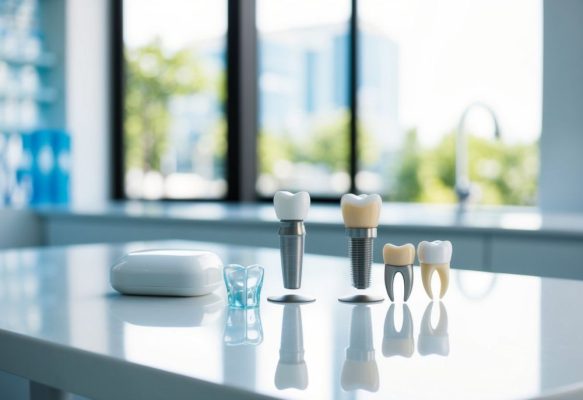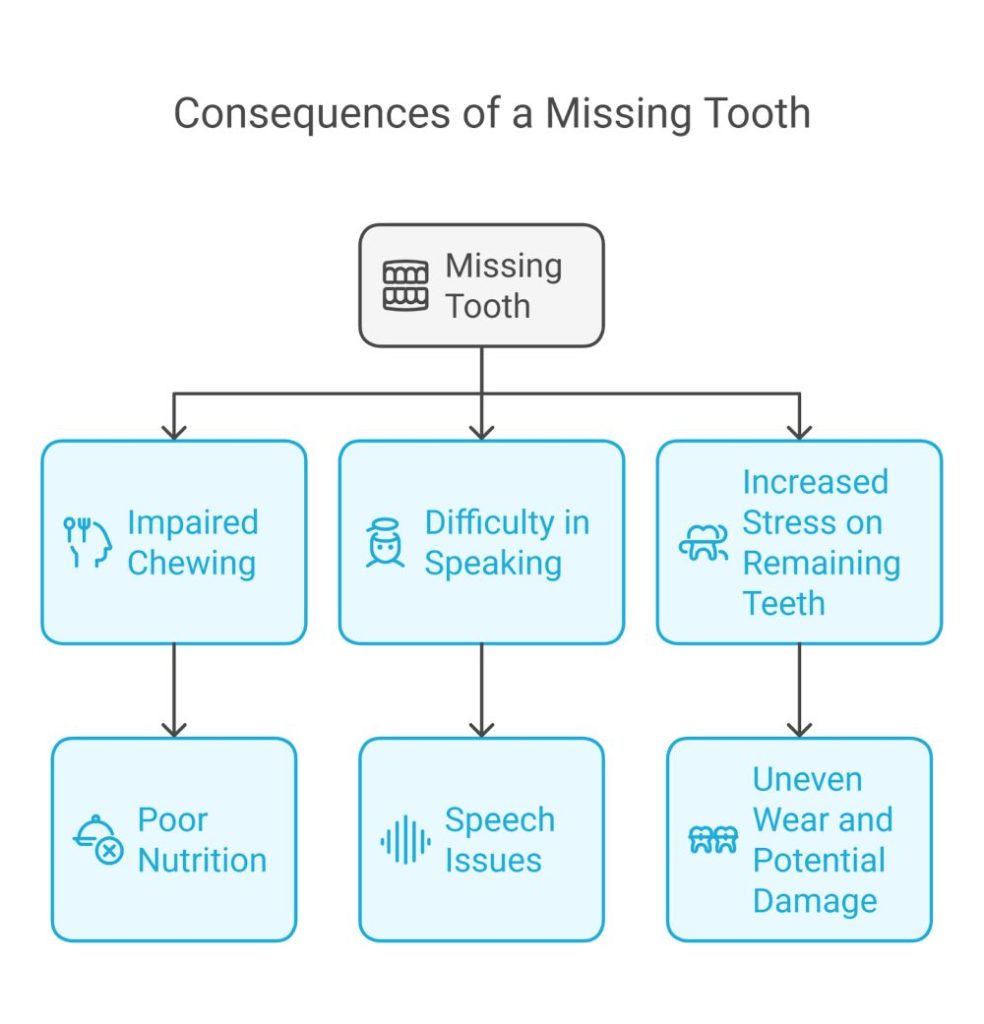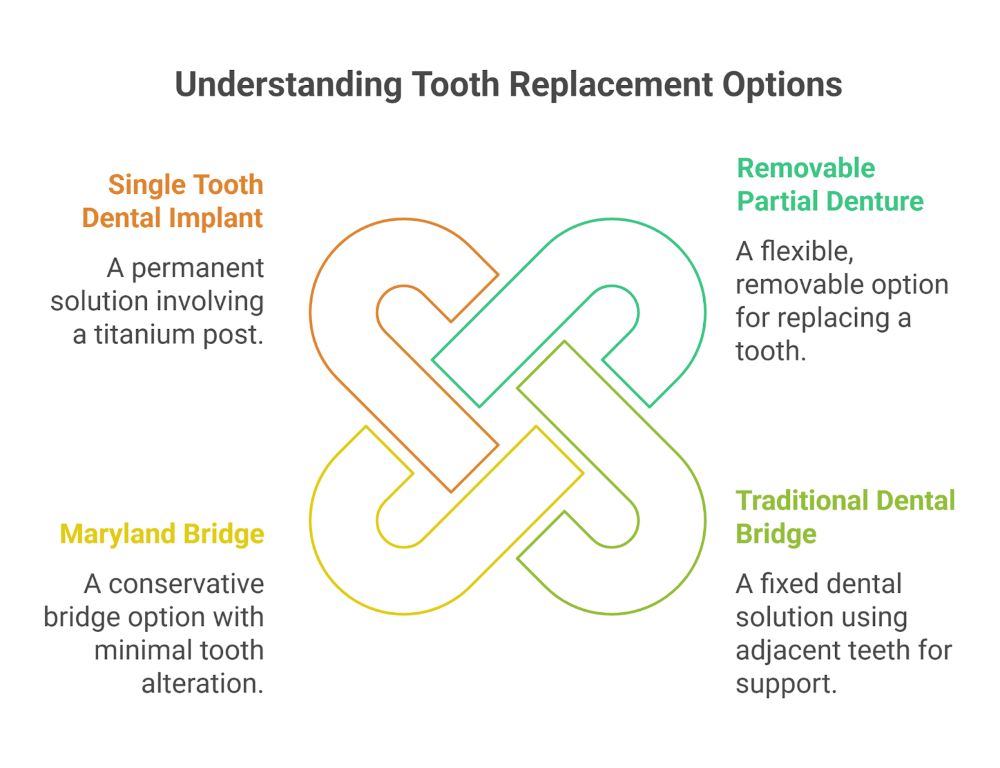
Guide to Single Tooth Replacement: Implants, Bridges, and More – Exploring Your Options for Dental Restoration
Last Updated: February 6, 2025 2:24 am | Medically Reviewed by Dr. Michael Berglass, DDS

Losing a single tooth can affect your smile and eating habits. Several ways can be used to replace a missing tooth, but dental implants offer a permanent solution that looks and feels like a natural tooth.
The use of dental implants in the United States has increased over time, with usage rising from 0.7% of patients missing at least one tooth in 1999–2000 to 5.7% in 2015–2016. Projections suggest that this figure could reach 26% by 2026.
Other options include bridges and removable partial dentures. Each choice has its own benefits and drawbacks. The best option depends on factors like overall health, budget, and personal preference.
Replacing a missing tooth is important for both looks and function. It helps keep other teeth in place and maintains the shape of your face. A dentist can help you pick the right option for your needs.

A missing tooth can cause many problems. Replacing it helps keep your mouth healthy and your smile looking good. It also makes eating and talking easier.
Replacing a lost tooth helps maintain normal chewing and speaking. However, when a tooth is missing, it can be difficult to eat certain foods, which can lead to poor nutrition.
Speaking clearly can also become difficult. The tongue and lips rely on teeth for proper sound formation, and a gap can cause lisping or whistling sounds.
Teeth work together as a team. A missing tooth puts extra stress on the remaining teeth. This can lead to uneven wear and potential damage over time.
A visible gap in the smile can affect a person’s confidence. It may make them self-conscious about laughing or smiling in public.
Missing teeth can change facial structure. The cheeks may start to sink in, making a person look older than they are.
Dental implants or bridges can restore a natural-looking smile. These options blend in with existing teeth, improving overall appearance.
Leaving a gap can cause nearby teeth to shift. This movement can lead to bite problems and make teeth harder to clean.
The jawbone needs stimulation from tooth roots to stay healthy. Without a tooth, the bone may start to shrink, a process called bone resorption.
Dental implants can prevent bone loss by mimicking natural tooth roots. They also provide the stimulation needed to keep the jawbone strong.
Replacing a missing tooth also helps prevent gum disease. Gaps can trap food and bacteria, increasing the risk of infection.

Losing a tooth can affect your smile and bite. Several options exist to replace a missing tooth. Each method has its own benefits and drawbacks.
A removable partial denture is a temporary fix for a missing tooth. It’s also called a flipper. This option is cheap and quick to make.
The denture has a fake tooth attached to a plastic base. It clips onto nearby teeth. You can take it out to clean it. Many people use a flipper while waiting for a permanent solution.
| Pros of a Partial Denture | Cons of a Partial Denture |
| Low cost | Not as stable as other options |
| Quick to make | It may feel bulky in the mouth |
| Easy to adjust | Needs to be removed for cleaning |
A dental bridge fills the gap left by a missing tooth. It is fixed in place and cannot be removed.
The bridge has three main parts:
The crowns go over the teeth next to the gap. This holds the fake tooth in place. Bridges can last many years with good care.
| Pros | Cons |
| Looks natural | Requires changing healthy teeth |
| Fixed in place | It can be hard to clean under |
| Restores bite function | It may need replacing after 5-7 years |
A Maryland bridge is less invasive than a traditional bridge. It uses metal wings to attach to nearby teeth. This avoids grinding down healthy teeth.
The fake tooth is held in place by the metal wings. These wings are bonded to the backs of adjacent teeth. It’s often used for front teeth.
| Pros | Cons |
| Preserves more natural tooth structure | Not as strong as traditional bridges |
| Less expensive than implants | It may not work well for back teeth |
| It can be a good option for front teeth | Metal wings might show when you smile |
A dental implant is the closest thing to a natural tooth. It’s a permanent solution that looks and works like a real tooth.
The implant has three parts:
Implants can last a lifetime with proper care. They don’t affect nearby teeth. They also help keep the jawbone healthy.
| Pros | Cons |
| Looks and feels natural | Most expensive option |
| Doesn’t affect other teeth | Requires surgery |
| Can last a lifetime | It takes several months to complete |
Missing a tooth? Get a long-lasting, natural-looking dental implant at West Palm Beach Family Dental. Our expert team ensures a seamless process for a confident smile. Schedule your consultation today!
If you’re ready to get started, call us now!
Selecting the right tooth replacement option involves weighing several key factors. These include your current oral health, budget, personal preferences, and lifestyle needs.
Your oral health plays a key role in determining the best tooth replacement option, as the condition of your teeth and gums affects which choices are viable. Dentists assess jawbone density, which is essential for dental implants since sufficient bone is needed to support the artificial root. Gum health is also important, as healthy gums improve the success rate of all tooth replacement methods. The condition of adjacent teeth also matters, especially for dental bridges, which rely on neighboring teeth for support. These teeth must be strong and free of cavities. Additionally, any ongoing dental issues may need to be addressed before moving forward with a replacement. A thorough dental evaluation ensures the most suitable option for long-term oral health.
Cost is often a major factor in choosing a tooth replacement method. Options vary widely in price.
Understanding these cost differences can help patients make an informed decision about their tooth replacement options.
Individual preferences play a big role in tooth replacement decisions. Some factors to consider include:
Implants often provide the most natural look and feel. They’re a popular choice for front teeth.
Bridges can also look very natural. They’re a good option for those wanting a fixed solution without surgery.
Removable partials work well for patients who prioritize affordability and easy maintenance.
A person’s lifestyle can influence their ideal tooth replacement choice. Consider these points:
Implants function most like natural teeth. They’re great for those with active lifestyles and varied diets.
Bridges require extra care when flossing. They may not suit those with limited dexterity.
Removable partials can be taken out for cleaning. This appeals to some patients, but others find it inconvenient.
Durability is key for long-term satisfaction. Implants typically last the longest, followed by bridges and then partials.
Choosing the right tooth replacement matters. Whether you need a dental implant, bridge, or denture, West Palm Beach Family Dental offers personalized solutions to restore your smile. Book an appointment now!
If you’re ready to get started, call us now!
Getting a single-tooth implant involves several steps spread out over a few months. The process requires careful planning and multiple appointments to ensure the best outcome.
The single-tooth implant journey starts with a thorough dental exam. The dentist will:
This visit helps determine if the patient is a good candidate for an implant. The dentist will explain the procedure, timeline, and costs involved.
Once the dentist confirms the patient’s suitability, they create a custom treatment plan. This plan includes:
The dentist may use advanced 3D imaging to precisely plan the implant placement. They’ll also discuss anesthesia options and provide pre-operative instructions.
The dental implant procedure begins with the surgical insertion of the implant. Key steps include:
This outpatient procedure typically takes 1-2 hours. The dentist may place a temporary crown to protect the site.
After surgery, the healing process begins. This crucial phase, called osseointegration, allows the implant to fuse with the jawbone. Key points:
During this time, patients may experience some discomfort and swelling. The dentist will provide pain management guidance and may prescribe antibiotics to prevent infection.
Once osseointegration is complete, the final steps occur:
This process usually requires 2-3 appointments. The result is a natural-looking replacement tooth that functions like a real tooth.
Proper care of your tooth replacement is key to its longevity and your oral health. Good habits and regular check-ups help keep your new tooth in top shape.
Brush your replacement tooth twice daily with a soft-bristled toothbrush. Use gentle circular motions to clean all surfaces. Floss carefully around the tooth to remove plaque and food particles.
For single-tooth implants, use an interdental brush or water flosser to clean hard-to-reach areas. These tools help prevent gum disease and implant failure.
Rinse with an antimicrobial mouthwash to kill bacteria and freshen your breath. Avoid abrasive toothpastes that can scratch the crown surface.
Visit your dentist every six months for cleanings and exams. They will check the fit and condition of your replacement tooth and may take X-rays to assess bone health around implants.
Professional cleanings remove tartar buildup that home care can miss. This helps prevent gum inflammation and infection.
Your dentist will also check your bite alignment. Improper bite can cause wear on the replacement tooth or neighboring teeth.
Avoid chewing hard foods like ice or nuts with your replacement tooth. This can chip or crack the crown. Cut tough foods into smaller pieces before eating.
Don’t smoke or use tobacco products. These habits increase the risk of gum disease and implant failure. They also stain tooth replacements.
Wear a night guard if you grind your teeth. Grinding puts excess pressure on replacement teeth and can cause damage over time.
Limit sugary and acidic foods and drinks. These can lead to decay around the edges of crowns or bridges. Rinse your mouth with water after consuming them.
Replacing a missing tooth is a big decision, and having a structured plan can make the process smoother. Our expert-approved checklist walks you through every important step—from evaluating your options to post-treatment care.
| Step | Action Items |
| Step 1: Assess Your Needs and Preferences | ✅ Identify if your missing tooth affects chewing, speech, or appearance ✅ Consider your budget and long-term cost-effectiveness ✅ Decide if you prefer a fixed or removable solution ✅ Evaluate your tolerance for surgical vs. non-surgical options |
| Step 2: Research Replacement Options | ✅ Learn about dental implants, bridges, and removable dentures ✅ Compare the pros and cons of each option based on durability, aesthetics, and maintenance ✅ Understand the timeline for each procedure (implants take longer but last longer) |
| Step 3: Check Your Oral Health Readiness | ✅ Schedule a dental consultation for a professional assessment ✅ Get X-rays or 3D imaging to evaluate jawbone density ✅ Discuss gum health and whether preparatory treatments (bone grafts, gum treatments) are needed ✅ Address any existing dental issues before proceeding |
| Step 4: Consider Financial Factors | ✅ Request a detailed cost estimate for each replacement option ✅ Check if your dental insurance covers part of the treatment ✅ Explore financing plans or payment options if needed ✅ Weigh the long-term costs (implants last longer but cost more upfront) |
| Step 5: Choose the Right Replacement Option | ✅ Discuss with your dentist the best fit for your lifestyle ✅ If considering an implant, confirm if your jawbone is strong enough ✅ If choosing a bridge, ensure adjacent teeth are healthy ✅ If opting for a partial denture, confirm it fits comfortably and securely |
| Step 6: Prepare for Treatment | ✅ Follow any pre-surgery instructions (if getting an implant) ✅ Arrange for transportation if sedation is involved ✅ Plan for healing time—dental implants take months to fully integrate ✅ Stock up on soft foods and pain management supplies |
| Step 7: Post-Treatment Care & Maintenance | ✅ Follow aftercare instructions to ensure proper healing ✅ Maintain good oral hygiene (brushing, flossing, using interdental brushes) ✅ Avoid chewing hard foods on the treated area during healing ✅ Schedule regular dental check-ups to monitor your replacement tooth ✅ If you grind your teeth, consider a night guard to protect your new tooth |
Choosing the right single tooth replacement option depends on many factors. Each person’s needs are different.
Dental implants offer a long-lasting solution that looks and feels natural. They help keep the jawbone healthy but cost more and require surgery.
Bridges are faster to place and may cost less upfront. They don’t need surgery. But they affect nearby healthy teeth and may not last as long.
Partial dentures are removable and affordable, and they work well for some people. However, they are not as stable or comfortable as fixed options.
Patients should talk to their dentist about which option best suits their situation. The dentist will consider oral health, budget, and personal preferences.
After getting a replacement tooth, regular dental check-ups are key. Good oral care at home is also important, as this helps the new tooth last longer.
With the right option and care, a replacement tooth can restore a smile for many years. It can improve eating, speaking, and confidence.
Don’t let a missing tooth affect your confidence and oral health! West Palm Beach Family Dental provides top-tier dental implants and bridges for a permanent, secure solution. Call us today to get started!
What are the advantages and disadvantages of dental implants for single tooth replacement?
Dental implants offer a long-lasting solution that looks and feels natural. With proper care, they can last a lifetime.
Implants also help maintain bone health in the jaw. The main drawback is the higher upfront cost compared to other options.
How does the cost of single tooth replacement options like dental bridges compare to dental implants?
Dental bridges are often less expensive initially than implants. However, bridges typically need replacement every 5-15 years.
Over time, the cost of replacing bridges may exceed that of a single implant. However, due to their durability, implants can be more cost-effective in the long run.
What types of dental implants are available for single tooth replacement, and which is most commonly recommended?
Single, stand-alone implants are the most common for replacing one tooth. These consist of a titanium post, abutment, and crown.
Dentists often recommend this type for its strength and natural appearance. Mini implants are sometimes used in narrow spaces but are less common.
Can a single tooth transplant be considered an alternative to dental implants or bridges?
Tooth transplants are rare and not widely available. They involve moving a tooth from one part of the mouth to another.
This option is limited by the availability of donor teeth and has a lower success rate than implants or bridges.
What should patients consider before deciding on dentures versus implants for single tooth replacement?
Removable partial dentures are less expensive than implants. They’re easier to clean but may feel less secure.
Implants offer a fixed solution that doesn’t require removal. When deciding, patients should consider their budget, oral health, and lifestyle.
What are the long-term outcomes and maintenance requirements for single tooth replacement options?
Implants have high success rates and, with proper care, often last a lifetime. They require regular brushing, flossing, and dental check-ups.
Bridges and dentures need more frequent replacements. Bridges may need special flossing tools. Dentures require daily removal and cleaning.